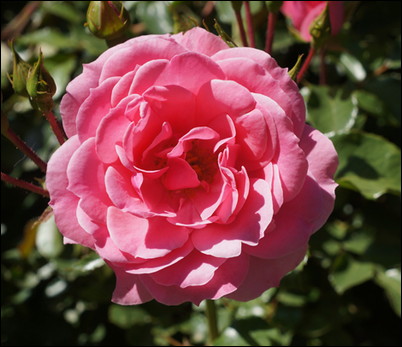June is the month of wine and roses. Look at their beauty. Inhale the fragrance. Watch the buds change from day to day. Cut some for the table. And open a nice bottle for you must have wine with roses. Roses are a very special hobby.
There are old roses, new roses, tea roses, climbing roses, rambling roses, constantly blooming but boring Knockout roses, hundreds of names and varieties. And each one has different blooming genes. Some are fragrant, newer varieties often are not. Each has its own special charm, much like each bottle of wine.
Pruning is a fine art! Each variety gets pruned a little differently. You have to like a challenge and like to experiment to enjoy this. I do. You also have to wear thick gloves that the thorns won’t go through.
A few tricks:
1. After a flower fades, cut it off a little above the next 5 leaf stalk. Not 3 leaves. A new flower bud will sprout from the 5 leaf stem. I can get 3 and sometimes even 4 successive blossoms each year from a vigorous stem.
2. Learn to recognize the age of a stem. New shoots are reddish and soft. The needles are reddish and very, very sharp. These shoots will give the most blossoms next year. If it comes from the ground, really cherish it, for it will become a main shoot. (To get more shoots from the ground, apply a little magnesium.)
3. On the vigorous main shoots and stems, the wood is strong and very green. The needles are green. These canes are the workhorses and produce the bulk of the flowers.
4. As the wood ages, it becomes brownish and finally tan and cracked. The tan stems will begin to produce poorly, signaling that it’s time to cut them back and make room for the new reddish shoots and the strong green stems.
5. When buying, always look for the word “vigorous” in the description. It means that it will grow despite some neglect and without too many problems. The problem is that the most beautiful roses are often not too vigorous.
6. A little fertilizer helps, but only apply before July 30. After that it can cause new shoots too late in the season, which may winter kill. I use rose fertilizer, but others might do just as well. I used to use one with pesticide included, but because of the problem with bees, I do not use systemic pesticides any more.
On the web, you can find much more information about rose care than you really want to know, to the point of exasperated boredom. And that is why, it’s always wine and roses for this hobby.
Ruth S. Foster is a landscape consultant and arborist. More gardening information can be found on her website, www.mothersgarden.net.




























